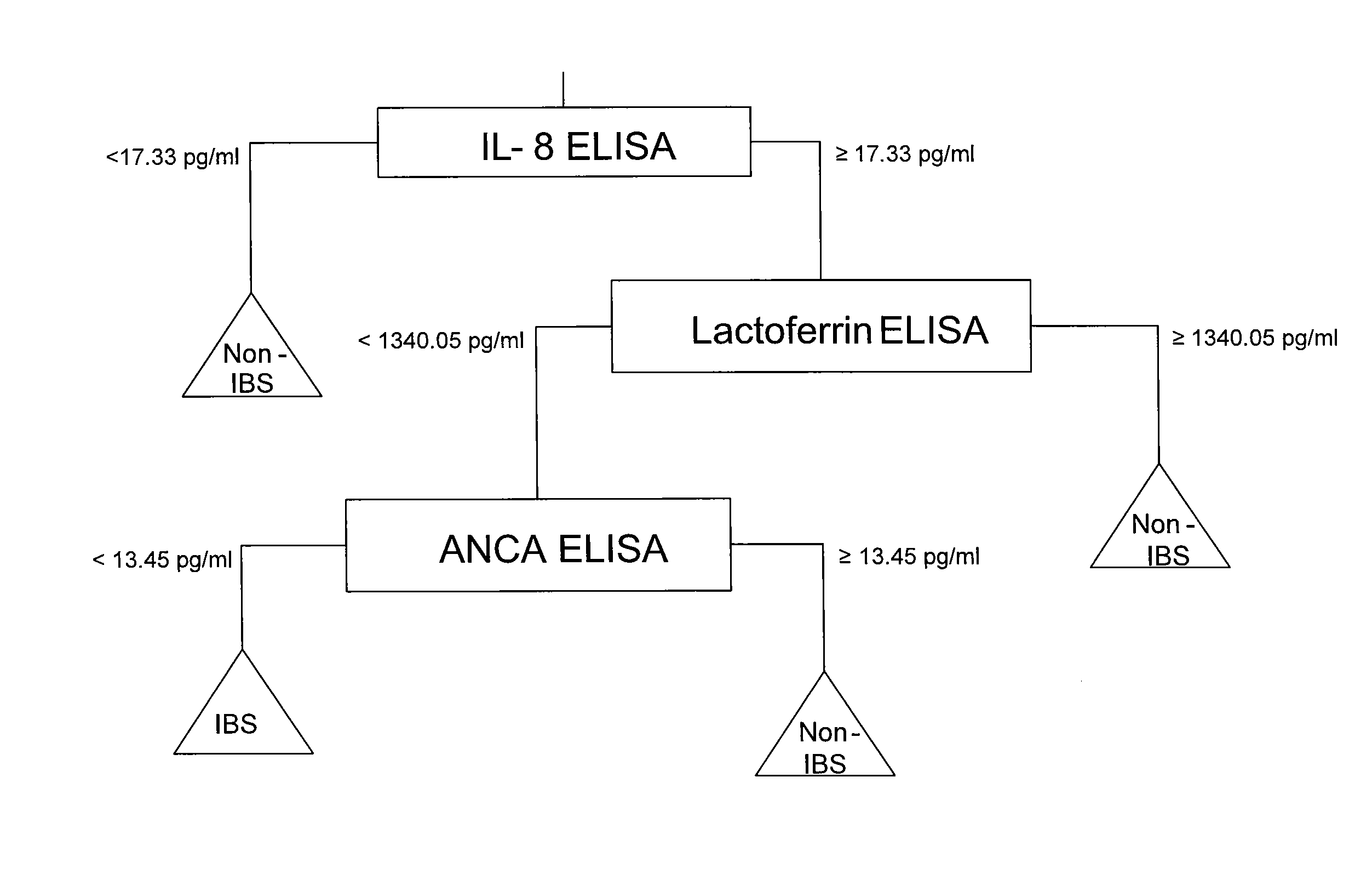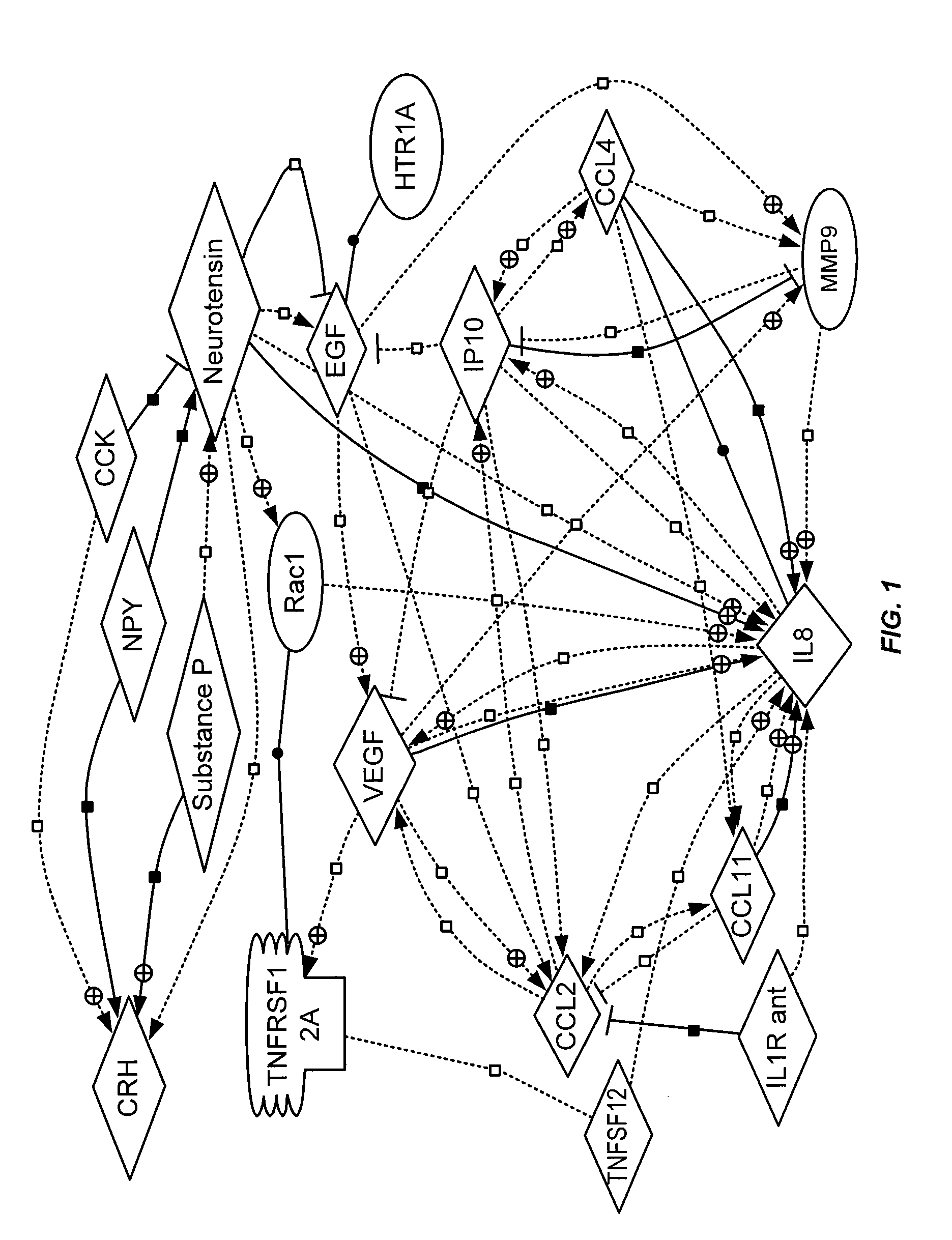Methods for diagnosing irritable bowel syndrome
a technology for irritable bowel syndrome and diagnostic methods, applied in the field of methods for diagnosing irritable bowel syndrome, can solve the problems of poor cognitive coping strategy, food is forced through the intestines more, gas, bloating, diarrhea, etc., and achieve the effect of accurate diagnosis prediction and accurate classification of ibs
- Summary
- Abstract
- Description
- Claims
- Application Information
AI Technical Summary
Benefits of technology
Problems solved by technology
Method used
Image
Examples
example 1
Leptin Discriminates Between IBS and Non-IBS Patient Samples
[0341] This example illustrates that determining the presence or level of leptin is useful for classifying a patient sample as an IBS sample, e.g., by ruling in IBS. The concentration of leptin was measured in serum samples from normal, IBS, IBD (i.e., CD, UC), and Celiac disease patients using an immunoassay (i.e., ELISA). As shown in FIG. 3, quartile analysis revealed that leptin levels were elevated in IBS samples relative to non-IBS (i.e., CD, UC, Celiac disease, normal) samples. Thus, leptin can advantageously discriminate between IBS and non-IBS samples.
[0342] Leptin is also useful for distinguishing between various forms of IBS. FIG. 4A shows the results of an ELISA where leptin levels were measured in normal, IBD (i.e., CD, UC), and Celiac disease patient samples and samples from patients having IBS-A, IBS-C, or IBS-D. Leptin levels were elevated in IBS-A and IBS-D patient samples relative to IBS-C samples. FIG. 4...
example 2
TWEAK Discriminates Between IBS and Non-IBS Patient Samples
[0343] This example illustrates that determining the presence or level of TWEAK is useful for classifying a patient sample as an IBS sample, e.g., by ruling in IBS. The concentration of TWEAK was measured in samples from normal, GI control, IBS, and IBD (i.e., CD, UC) patients using an immunoassay (i.e., ELISA). As shown in FIG. 5, quartile analysis revealed that TWEAK levels were elevated in IBS samples relative to non-IBS (i.e., CD, UC, GI control, normal) samples. Thus, TWEAK can advantageously discriminate between IBS and non-IBS samples.
example 3
IL-8 Discriminates Between IBS and Normal Patient Samples
[0344] This example illustrates that determining the presence or level of IL-8 is useful for classifying a patient sample as an IBS sample, e.g., by ruling in IBS. The concentration of IL-8 was measured in samples from normal, GI control, IBS, IBD (i.e., CD, UC), and Celiac disease patients using an immunoassay (i.e., ELISA). As shown in FIG. 6A, quartile analysis revealed that IL-8 levels were elevated in IBS samples relative to normal samples. Thus, IL-8 can advantageously discriminate between IBS and normal patient samples.
[0345]FIG. 6B shows a cumulative percent histogram analysis demonstrating that IL-8 discriminates about 45% of IBS patient samples from normal patient samples at a cutoff level of 40 pg / ml. IL-8 can also discriminate about 55% of Celiac disease patient samples from normal patient samples at the same cutoff level. FIG. 7 shows a cumulative percent histogram analysis demonstrating that IL-8 discriminates ...
PUM
| Property | Measurement | Unit |
|---|---|---|
| time | aaaaa | aaaaa |
| threshold | aaaaa | aaaaa |
| frequency | aaaaa | aaaaa |
Abstract
Description
Claims
Application Information
 Login to View More
Login to View More - R&D
- Intellectual Property
- Life Sciences
- Materials
- Tech Scout
- Unparalleled Data Quality
- Higher Quality Content
- 60% Fewer Hallucinations
Browse by: Latest US Patents, China's latest patents, Technical Efficacy Thesaurus, Application Domain, Technology Topic, Popular Technical Reports.
© 2025 PatSnap. All rights reserved.Legal|Privacy policy|Modern Slavery Act Transparency Statement|Sitemap|About US| Contact US: help@patsnap.com



